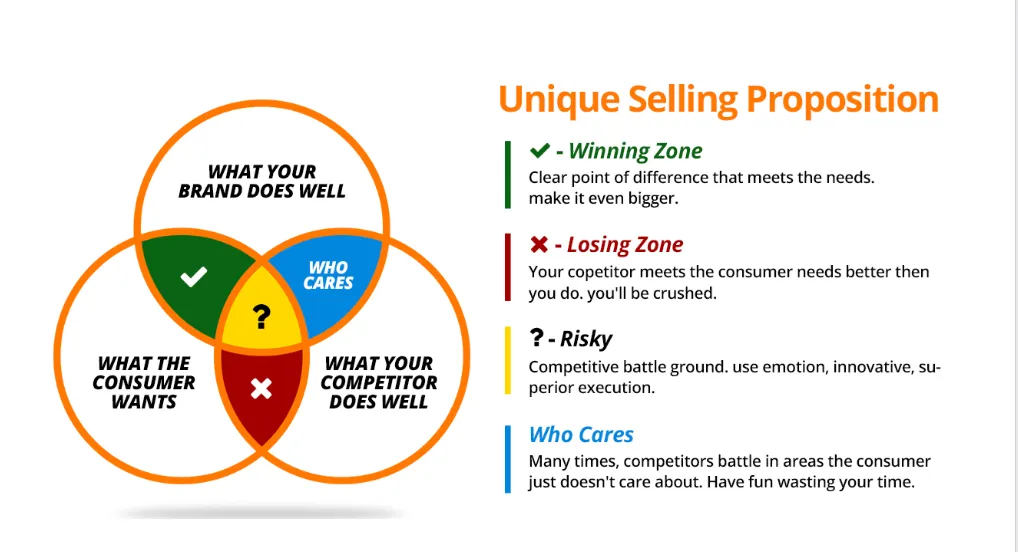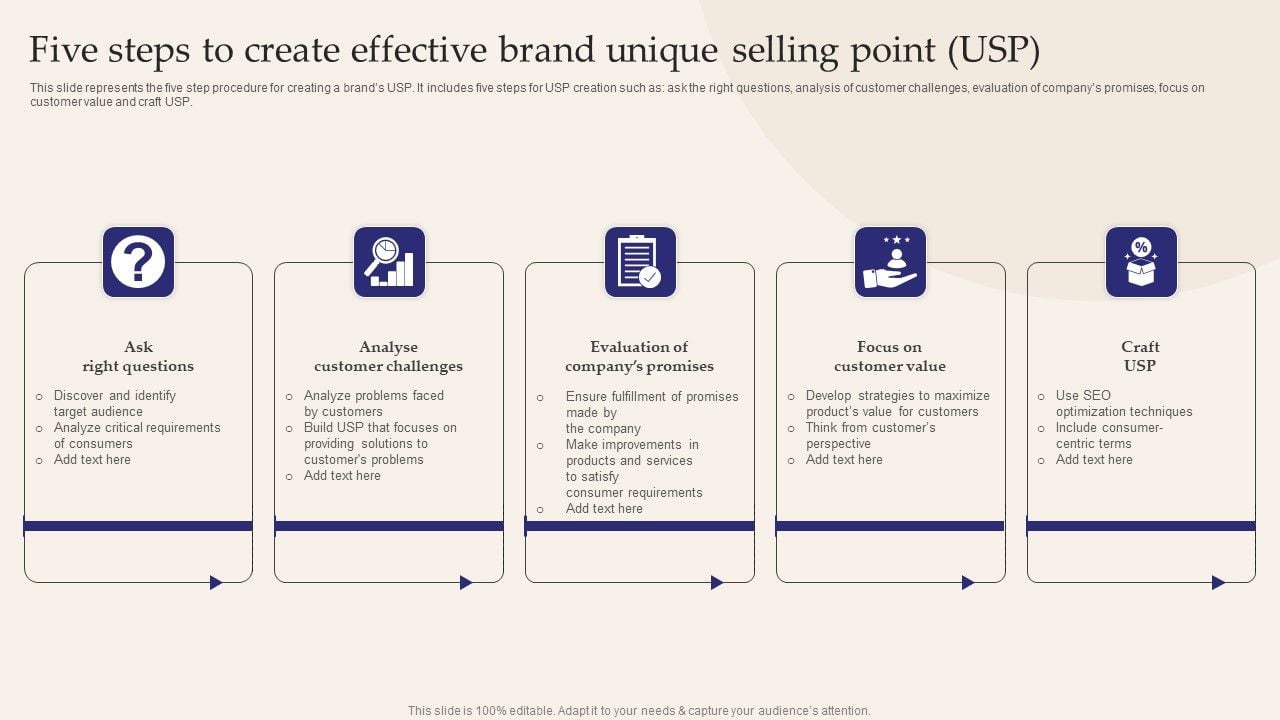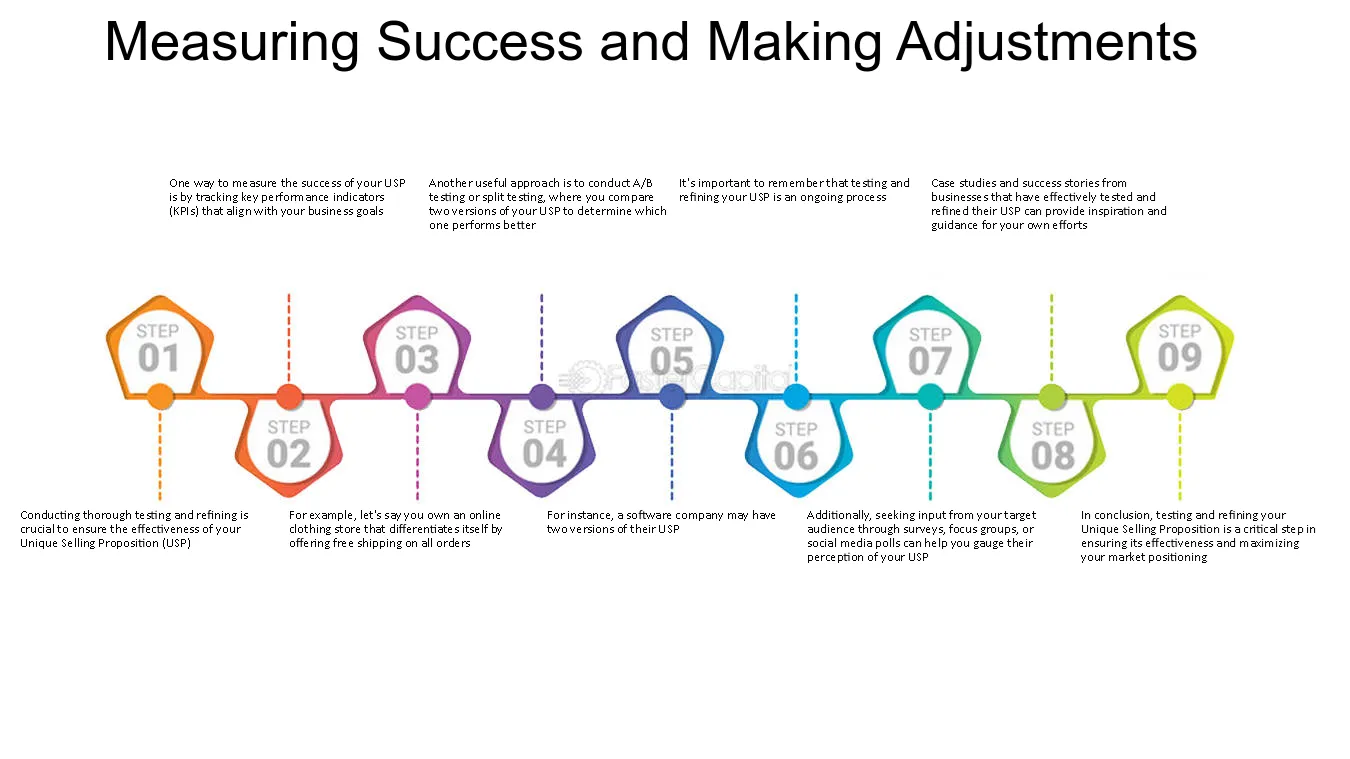In the bustling arena of modern business, standing out is not just an advantage—it’s a necessity. But how does one truly differentiate in a saturated market? The answer lies in understanding and utilizing Unique Selling Points (USPs). A concept that has evolved over decades, USPs are the cornerstone of any successful brand strategy. They are the distinctive factors that set a business apart from its competitors, capturing the essence of its value proposition.
USP (Unique Selling Proposition) is no longer a strange concept to those working in the field of Marketing. This is a key factor that helps position your product or service differently from competitors while creating a deep impression in the minds of customers. So what is USP really? How to build a strong USP for a product? Let’s discover the details in this article!
What is USP?
USP (Unique Selling Point or Unique Selling Proposition) is a term that means “unique selling point”. This is an important element in marketing and business that helps identify the unique features, benefits, or values that your product or service offers—things that your competitors cannot copy. Such as the lowest price, superior quality, smallest size, or ultimate product safety.
Unique Selling Points (USPs) are the defining characteristics of a product or service that make it stand out from the competition. They encapsulate what makes a business unique and communicate why consumers should choose it over others. USPs can be based on various factors, including product features, pricing, quality, customer service, or even the brand’s mission and values.
A USP is not only an opportunity for a business to differentiate itself, but it is also the key to effectively building a Brand and attracting potential customers. With a USP, your product can stand out in a crowded market, leave a lasting impression in the minds of consumers and help them realize that this is the best choice.
In Marketing, USP is a powerful tool to determine the position of a product in the market, and at the same time reflect the core value that the business is committed to bringing to customers. It is likened to “what you have but your competitors do not.”
The importance of USPs cannot be overstated. They are crucial in shaping consumer perceptions and driving purchasing decisions. A well-defined USP answers the fundamental question: “Why should customers buy from you and not the competition?” By articulating this clearly, businesses can create a compelling narrative that resonates with their target audience.

The Role of USP in Marketing
USP (Unique Selling Proposition) is an important factor that contributes to many different aspects of marketing strategy, helping businesses build a strong image and attract customers. Here are some of the key roles of USP in Marketing:
Branding and market positioning: USP is an important tool in building a strong brand, helping to shape the brand’s personality and core values, thereby creating a unique and distinct image in the minds of customers. When you establish a clear and valuable USP, it not only attracts customers but also helps your brand dominate the market effectively.
Differentiate yourself from your competitors: A USP helps your product or service stand out from the crowd. By providing unique features that your competitors cannot copy, customers will easily recognize what makes your product special and valuable, making it their preferred choice.
Attracting potential customers: A strong USP not only grabs attention but also piques curiosity in potential customers. This is key to enticing them to learn more about your product or service, opening up opportunities for engagement and conversion.
Building trust and adding value to customers: When your USP highlights the specific benefits your product or service offers, customers will easily perceive value and trust. This trust is a solid foundation for maintaining long-term relationships and driving purchasing decisions.
Marketing strategy orientation: A USP helps define the direction of your marketing strategy, from how you promote and create content to how you engage with your customers. It plays a crucial role in determining what to focus on and how to effectively approach the market.

Steps to Build an Effective USP to Make Your Product Stand Out
Step 1: Research your target market carefully
The first step to establishing a solid USP is to have a deep understanding of your target market. This includes understanding your target audience, the competitive landscape, market trends, and other relevant factors. This will give you a clear picture of the context in which your product or service will exist, which will help guide your strategy accordingly.
- Market overview: This research helps you determine the size of the market, what trends are happening, and what factors might influence your product.
- Audience segmentation: Clearly define each customer segment you want to target. Who are they? What are their specific needs? A deep understanding of these segments will help you create a relevant and compelling USP.
Step 2: Understand customer needs
To create a successful USP, a business needs to understand the core needs that customers value in their product or service. This requires a keen understanding of the psychology and real needs of customers. Some methods for discovering this include:
- Survey and collect feedback: Use survey tools to listen to your customers to find out what problems they are facing and how your product or service can solve them.
- Expert advice: Consult with industry experts. These people can provide more insight into the market and help you identify a valuable USP.
Step 3: Competitor Analysis
In business, it is important to understand your competitors. Analyzing how they do business, their Sales strategies, offers, and customer service will give you the insight to build a perfect USP.
- Learn but don’t copy: Find out what your competitors do well, then turn it to your advantage by creating a unique USP. Also, identify gaps in your competitors’ strategies that your product or service can fill.
Step 4: Identify unique strengths
Leverage information from market research, understanding customer needs, and competitor analysis to identify the unique elements that your product or service possesses. These strengths should create a real differentiation and provide significant value to customers.
- Fill the gap: Find areas where your competitors are not meeting their needs and make sure your product or service can fill them. Choose strengths that will help your product stand out and create unique value for your customers.
Step 5: Maintain and develop the difference
To keep your USP relevant, you need to not only maintain it, but also continuously develop it.
- Listen to feedback: Regularly listen to customer feedback to understand how they perceive your USP and look for ways to improve it over time.
- Integration and extensibility: Develop elements of your USP to add value. This could include adding new features, improving the customer experience, or expanding the product range.
- Adapting to change: Continuously monitor market fluctuations and new trends to ensure your USP stays relevant and appealing to your customers.

Strategies for Developing a Unique and Effective USP for Your Product
To develop a truly unique and effective USP (Unique Selling Proposition), try putting yourself in your customer’s shoes and ask yourself:
- What makes your product or service stand out?
-
-
- What features do you have that your competitors can’t offer?
- What specific benefits does your product/service bring to your customers?
-
- How does your product or service improve your customers’ lives?
-
-
- What positive changes does your product or service bring to your customers’ lives?
-
- Why should customers choose you over your competitors?
-
-
- What advantages does your product or service have that your competitors can’t match?
-
- How to make your USP message truly compelling and clear?
-
-
- What words or images can you use to highlight your USP?
-
- How does your product or service fit into your customer’s values and lifestyle?
-
-
- What aspects of your USP create a strong connection with your customers?
-
- How to maintain and upgrade USP over time?
-
- How can you expand and evolve your USP to consistently meet the ever-increasing expectations and needs of your customers?
Case Studies of Successful USPs
Examining real-world examples of successful Unique Selling Points (USPs) provides valuable insights into what works and why. These case studies highlight how brands have effectively leveraged their USPs to achieve business success and capture the hearts of consumers.
Real-World Examples
- Apple: Apple’s USP revolves around its commitment to design innovation, simplicity, and seamless user experience. The brand’s emphasis on sleek aesthetics and intuitive functionality has cultivated a loyal customer base and established Apple as a leader in the tech industry.
- Tesla: Tesla’s USP is rooted in its mission to accelerate the world’s transition to sustainable energy. By pioneering electric vehicles with cutting-edge technology and unmatched performance, Tesla has positioned itself as a visionary brand, appealing to environmentally conscious consumers.
- Nike: Nike’s “Just Do It” campaign encapsulates its USP of empowering athletes and promoting a mindset of determination and achievement. The brand’s focus on inspiration and performance has resonated with consumers worldwide, making Nike a dominant force in the sports industry.
- Warby Parker: Warby Parker disrupted the eyewear market with its USP of affordable, stylish glasses paired with a commitment to social responsibility. By offering a direct-to-consumer model and donating a pair of glasses for every pair sold, Warby Parker has attracted a socially conscious audience.
- Patagonia: Patagonia’s USP centers on environmental sustainability and ethical business practices. By prioritizing eco-friendly materials and advocating for conservation efforts, Patagonia has built a loyal following among consumers who value sustainability.
- Starbucks: Starbucks’ USP focuses on the customer experience and premium quality. The brand offers a unique coffeehouse experience, with a focus on high-quality coffee, personalized service, and a comfortable atmosphere. This USP has helped Starbucks become a global leader in the coffee industry.
These case studies demonstrate the power of a well-defined USP in driving brand success. By aligning their USPs with their core values and consumer expectations, these brands have created a lasting impact and secured a competitive edge in their respective markets.
Challenges in Defining USPs
While crafting a Unique Selling Point (USP) is essential for business success, it is not without its challenges. Defining a compelling and effective USP requires careful consideration and strategic planning. Let’s explore some common challenges businesses face in this process and how to overcome them.
Overcoming Common Pitfalls
- Lack of Differentiation: One of the most significant challenges is creating a USP that truly sets your brand apart. Many businesses struggle to identify unique attributes that distinguish them from competitors. To overcome this, focus on understanding your strengths, analyzing competitors, and identifying gaps in the market.
- Inconsistent Messaging: A USP must be consistently communicated across all channels to be effective. Inconsistent messaging can confuse consumers and dilute the brand’s identity. Ensure that your USP is integrated into your marketing strategy and conveyed consistently across all touchpoints.
- Failure to Connect with Customers: A USP that doesn’t resonate with the target audience will fail to drive engagement. It’s essential to align your USP with customer needs and preferences. Conduct market research and gather feedback to ensure your USP is relevant and meaningful to your audience.
- Neglecting the Emotional Appeal: While rational benefits are important, a USP that lacks emotional appeal may struggle to create a lasting impact. Incorporate storytelling and emotional elements into your USP to forge a deeper connection with consumers.
- Resistance to Change: As markets evolve, so too should your USP. Businesses that resist adapting their USP to changing conditions risk becoming obsolete. Stay agile and open to refining your USP to reflect new trends and consumer demands.
By addressing these challenges and adopting a strategic approach, businesses can define a USP that resonates with consumers, differentiates their brand, and drives long-term success.
Online Marketing Campaigns and USPs
In the digital age, online marketing campaigns play a crucial role in promoting Unique Selling Points (USPs) and reaching a wider audience. Effective online marketing strategies can amplify your USP and engage consumers in meaningful ways. Here’s how to leverage online marketing for your USP.
Effective Digital Strategies
- Utilize Social Media Platforms: Social media is a powerful tool for showcasing your USP and engaging with your audience. Use platforms like Instagram, Facebook, and Twitter to share compelling content, visuals, and stories that highlight your unique offerings.
- Invest in Content Marketing: Create valuable and informative content that aligns with your USP. Blog posts, videos, podcasts, and infographics can educate consumers, build trust, and reinforce your brand’s unique value proposition.
- Implement SEO Best Practices: Optimize your website and content for search engines to increase visibility and attract organic traffic. Use relevant keywords, meta descriptions, and high-quality backlinks to enhance your online presence and highlight your USP.
- Leverage Email Marketing: Email marketing allows for personalized communication with your audience. Use targeted email campaigns to promote your USP, offer exclusive deals, and nurture relationships with customers.
- Engage with Influencers: Partner with influencers who align with your brand values and resonate with your target audience. Influencers can amplify your USP through authentic endorsements and reach a broader audience.
- Utilize Pay-Per-Click (PPC) Advertising: Invest in PPC advertising to promote your USP and drive targeted traffic to your website. Tailor your ad copy and landing pages to highlight your unique benefits and encourage conversions.
By integrating these digital strategies into your online marketing campaigns, you can effectively communicate your USP, engage with consumers, and drive business success in the digital landscape.

Measuring the Effectiveness of USPs
To ensure that your Unique Selling Point (USP) is driving the desired impact, it’s essential to measure its effectiveness. By tracking key performance indicators (KPIs) and analyzing data, businesses can evaluate the success of their USP and make informed decisions for improvement.
KPIs and Analytics
- Sales and Revenue Growth: Monitor sales and revenue metrics to assess the impact of your USP on business performance. An increase in sales and revenue can indicate that your USP is resonating with consumers and driving purchasing decisions.
- Customer Acquisition and Retention: Track customer acquisition and retention rates to evaluate the effectiveness of your USP in attracting and retaining customers. A strong USP should not only draw new customers but also foster loyalty among existing ones.
- Brand Awareness and Recognition: Measure brand awareness and recognition through surveys, social media metrics, and online mentions. A successful USP should enhance brand visibility and establish a distinct identity in the market.
- Customer Feedback and Satisfaction: Gather feedback from customers to understand their perceptions of your USP. Use surveys, reviews, and testimonials to gauge customer satisfaction and identify areas for improvement.
- Website Traffic and Engagement: Analyze website traffic and engagement metrics, such as page views, bounce rates, and time on site. A compelling USP should drive traffic to your website and encourage visitors to explore your offerings.
- Conversion Rates: Monitor conversion rates to evaluate how effectively your USP is driving desired actions, such as purchases, sign-ups, or inquiries. Optimize your USP and marketing strategies to improve conversion rates.
By regularly measuring these KPIs and leveraging analytics, businesses can gain valuable insights into the effectiveness of their USP and make data-driven decisions to enhance their value proposition and achieve business success.
USPs in Different Industries
Unique Selling Points (USPs) are not one-size-fits-all; they must be tailored to the specific needs and dynamics of each industry. Let’s explore how USPs can be adapted to different industries and the impact they have on business success.
Tailoring USPs to Industry Needs
- Retail and Consumer Goods: In the retail industry, USPs often focus on product quality, affordability, and convenience. Brands like Amazon emphasize fast delivery and a vast selection, while luxury brands highlight exclusivity and craftsmanship.
- Technology and Software: For technology companies, USPs revolve around innovation, user experience, and cutting-edge features. Brands like Google and Microsoft focus on reliability, security, and integration across platforms.
- Healthcare and Pharmaceuticals: In healthcare, USPs emphasize safety, efficacy, and patient care. Pharmaceutical companies like Pfizer highlight research and development, while healthcare providers prioritize personalized care and advanced treatment options.
Conclusion
In conclusion, a Unique Selling Point (USP) is a critical element for business success. It sets your product or service apart from the competition and provides a clear and compelling reason for customers to choose your brand. By understanding the key elements of a strong USP, identifying and crafting your USP statement, and effectively implementing it in your marketing efforts, you can create a powerful brand identity that resonates with your target audience. Regularly reviewing and updating your USP ensures that it remains relevant and effective in driving business growth. Embrace the power of a well-defined USP and watch your business thrive in the competitive marketplace.
USP is an indispensable tool to help businesses shine in the crowd of competitors. From the buyer’s perspective, USP is the answer to the important question: “Why should customers choose your product or service among thousands of other options?”. Therefore, to create a prominent difference and optimize competitive advantage in the field of marketing and business, businesses need to make efforts to find and develop a unique USP. This means creating special value that only your product or service can bring, thereby building a strong and memorable image in the minds of customers.
FAQs
What is a Unique Selling Point?
A Unique Selling Point (USP) is a distinct characteristic or benefit that sets a product or service apart from its competitors. It is the unique factor that makes your brand stand out in the marketplace.
How do I identify my USP?
Identifying your USP involves conducting market research, gathering customer feedback, analyzing competitors, and performing a SWOT analysis. This helps to identify the unique benefits of your product or service that resonate with your target audience.
Can a business have more than one USP?
Yes, a business can have more than one USP. However, it is important to ensure that each USP is clear, specific, and relevant to your target audience. Having multiple USPs can help to appeal to different customer segments and differentiate your brand in the market.
How often should I review my USP?
It is important to regularly review your USP to ensure that it remains relevant and effective. This can be done annually or whenever there are significant changes in the market or your business. Regularly reviewing your USP helps to ensure that it continues to resonate with your target audience and drive business success.
What are some common mistakes in creating a USP?
Common mistakes in creating a USP include being too vague, focusing on features instead of benefits, and failing to differentiate from competitors. It is important to ensure that your USP is clear, specific, and highlights what makes your product or service unique.
How can I measure the success of my USP?
Measuring the success of your USP involves tracking key performance indicators (KPIs), conducting customer surveys, and analyzing sales data. This helps to determine the impact of your USP on business performance and identify areas for improvement.
Comment Policy: We truly value your comments and appreciate the time you take to share your thoughts and feedback with us.
Note: Comments that are identified as spam or purely promotional will be removed.
To enhance your commenting experience, consider creating a Gravatar account. By adding an avatar and using the same e-mail here, your comments will feature a unique and recognizable avatar, making it easier for other members to identify you.
Please use a valid e-mail address so you can receive notifications when your comments receive replies.
